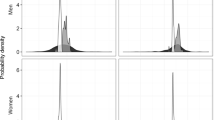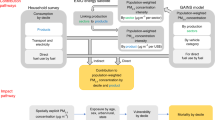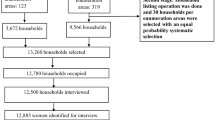Abstract
Indoor air pollution associated with combustion of solid fuels seems to be a major contributor to the national burden of disease in India, but relatively few quantitative exposure assessment studies are available. This study quantified the daily average concentrations of respirable particulates (50% cut-off at 4 μm) in 412 rural homes selected through stratified random sampling from three districts of Andhra Pradesh, India and recorded time activity data from 1400 individuals to reconstruct 24-h average exposures. The mean 24-h average concentrations ranged from 73 to 732 μg/m3 in gas- versus solid fuel-using households, respectively. Concentrations were significantly correlated with fuel type, kitchen type, and fuel quantity. The mean 24-h average exposures ranged from 80 to 573 μg/m3. Among solid fuel users, the mean 24-h average exposures were the highest for women cooks and were significantly different from men and children. Among women, exposures were the highest in the age group of 15–40 years (most likely to be involved in cooking or helping in cooking), while among men, exposures were highest in the age group of 65–80 years (most likely to be indoors). The data are being used to develop a model to predict quantitative categories of population exposure based on survey information on housing and fuel characteristics. This would facilitate the development of a regional exposure database and enable better estimation of health risks.
This is a preview of subscription content, access via your institution
Access options
Subscribe to this journal
Receive 6 print issues and online access
$259.00 per year
only $43.17 per issue
Buy this article
- Purchase on Springer Link
- Instant access to full article PDF
Prices may be subject to local taxes which are calculated during checkout







Similar content being viewed by others
Notes
The energy ladder (Reddy and Reddy, 1994) is made up of several rungs with traditional fuels such as wood, dung, and crop residues occupying the lowest rung. Charcoal, coal, kerosene, gas, and electricity represent the next higher steps sequentially. As one moves up the energy ladder, energy efficiency and costs increase, while typically the pollutant emissions decline. While several factors influence the choice of household energy, household income has been shown to be the one of the most important determinants. The use of traditional fuels and poverty thus remain closely interlinked.
In India, the next administrative unit smaller than districts is the mandal, which in turn is subdivided into villages and further subdivided into habitations.
Separate enclosed indoor kitchens (Type 1) typically were well separated from the living areas and also usually better ventilated. Enclosed indoor kitchens without partitions (Type 2) typically had very little separation between the cooking area and the adjacent living area. Most importantly, since these households had only one indoor area that was used for cooking and all other indoor activities including sleeping, the potential for exposures is maximal in this configuration. Separate enclosed kitchens outside the house (Type 3) were somewhat difficult to define. While few households had definite walled kitchens outside the main living areas, on many occasions, they were semienclosed and some were connected through corridors to the rest of the house and therefore not truly outside the house. Outdoor kitchens (Type 4) typically had stoves kept in the open without any enclosures or occasionally had a thatched roof on top to protect from rain, but were open on all other sides.
The exposure questionnaire was written in English, but administered in the local language by the study team. It was validated by independent repeat administration on consecutive days in approximately 10% of the households. Also in 10% of households, duplicate measurements were taken on consecutive days and the levels were not significantly different (paired t-test). The field supervisors crosschecked all field forms after each day of monitoring activity to ensure that the forms were completely filled out by the field assistants. Two independent data entry operators verified computer data entry in the laboratory prior to analyses using the SPSS package (Version 10.0).
Most measurements actually lasted somewhat less than 24 h, although never less than 22 h. For consistency and convenience, however, we report them here as “24-h” measurements.
References
Aggarwal A.L., Raiyani C.V., and Patel P.D., et al. Assessment of exposures to benzo(a)pyrene in air for various population groups in Ahmedabad. Atmos Environ 1982: 16: 867–870.
Albalak R., Bruce N., McCracken J., Smith K.R., and Gallardo T. Indoor respirable particulate matter concentrations from an open fire, improved cook stove and LPG/open fire combination in a rural Guatemalan community. Environ Sci Technol 2001: 35: 2650–2655.
Armstrong J.R., and Campbell H. Indoor air pollution and lower respiratory infections in young Gambian children. Int J Epidemiol 1991: 20(2): 424–429.
Awasthi S., Glick H., and Fletcher R. Effect of cooking fuels on respiratory diseases in preschool children in Lucknow, India. Am J Trop Med Hyg 1996: 55(1): 48–51.
Balakrishnan K., Parikh J., Sankar S., Padmavathi R., Srividya K., Vidhya V., Prasad S., and Pandey V. Daily average exposures to respirable particulate matter from combustion of biomass fuels in rural households of Southern India. Environ Health Perspect 2002: 110: 1069–1075.
Barnes D.F., Openshaw K., Smith K.R., and Van der Plas R. What Makes People Cook with Improved Biomass Stoves? A Comparative International Review of Stove Programs. The World Bank, Washington, DC, 1994.
Behera D., Jindal S.K., and Malhotra H.S. Ventilatory function in non-smoking rural Indian women using different cooking fuels. Thorax 1991: 46(5): 344–346.
Bruce N., Neufeld L., Boy E., and West C. Indoor biofuel air pollution and respiratory health: the role of confounding factors among women in highland Gautemala. Int J Epidemiol 1998: 27: 454–458.
Bruce N., Perez-Padilla R., and Albalak R. Indoor air pollution in developing countries: a major environmental and public health challenge. Bull WHO 2000: 78: 1078–1092.
Census of India. New Delhi: India, office of the Registrar General and Census Commissioner, Government of India, 1991.
Cooper J.A. Environmental impact of residential wood combustion emissions and its implications. J Air Pollution Control Assoc 1980: 30: 855–886.
Duan N., Dobbs A., and Ott W. Comprehensive definitions of exposure and dose to environmental pollution. In: General Organising Committee (Eds.). Total Exposure Assessment Methodology, Proceedings of the EPA/A &WMA Specialty Conference, Las Vegas, Nevada, 1989.
Ellegard A. Cooking fuel smoke and respiratory symptoms among women of low income areas of Maputo. Environ Health Perspect 1996: 104: 980–985.
Ezzati M., and Kammen D.M. Quantifying the effects of exposure to indoor air pollution from biomass combustion on acute respiratory infections in developing countries. Environ Health Perspect 2001: 109: 481–489.
Ezzati M., Saleh H., and Kammen D.M. The contributions of emissions and spatial microenvironments to exposure to indoor air pollution from biomass combustion in Kenya. Environ Health Perspect 2000: 108: 833–839.
Masera O.R., Saatkamp D.B., and Kammen D.M. From linear switching to multiple cooking strategies: a critique and alternative to the energy ladder model. World Dev 2000: 28(12): 2083–2103.
McCracken J.P., and Smith K.R. Emissions and efficiency of improved wood burning cook stoves in high land Guatemala. Environ Int 1998: 24(7): 739–747.
Mishra V., and Retherford R.D. Cooking smoke increases the risk of acute respiratory infections in children. Nat Family Health Surv Bull 1997: (8): 1–4.
National Institute for Occupational Safety and Health. Nuisance Dust, Respirable (Method 0600). NIOSH Manual of Analytical Methods. NIOSH, Washington, DC, 1984.
National Sample Survey Organization (NSS). New Delhi: Department of Statistics, Government of India. Household consumer expenditure in India 1999–2000: Key results. Report No: 453, 2000.
Pandey M.R., Neupane R.P., Gautam A., and Shrestha I.B. The effectiveness of smoke less stoves in reducing indoor air pollution in rural hill region of Nepal. Mountain Res Dev 1990: 10: 313–320.
Parikh J., Balakrishnan K., Pandey V., and Biswas H. Exposure from cooking with biofuels; pollution monitoring and analysis for rural Tamilnadu, India. Energy 2001: 26: 949–962.
Reddy A.K.N., and Reddy B.S. Substitution of energy carriers for cooking in Bangalore. Energy 1994: 19: 561–571.
Reddy A.K.N., Williams R.H., and Johansson T.B. Energy after Rio: Prospects and Challenges. United Nations Publications, New York, 1996.
Reid H., Smith K.R., and Sherchand B.J. Indoor smoke exposures from traditional and improved cookstoves: comparisons among rural Nepali women. Mountain Res Dev 1986: 6: 293–304.
Saksena S., Prasad R., Pal R.C., and Joshi V. Patterns of daily exposure to TSP and CO in the Garhwal Himalaya. Atmos Env 1992: 26A(11): 2125–2134.
Smith K.R. Biofuels, Air Pollution and Health. A Global Review. Plenum Press, New York, 1987.
Smith K.R. Fuel combustion air pollution and health: the situation in developing countries. Ann Rev Energy Environ 1993: 18: 529–566.
Smith K.R., Apte M.G., Yoqing M., Wongsekiarttirat W., and Kulkarni A. Energy 1994: 19: 587–600.
Smith K.R. The national burden of disease in India from indoor air pollution. Proc Natl Acad Sci 2000: 97: 13286–13293.
Smith K.R., Aggarwal A.L., and Dave R.M. Air pollution and rural biomass fuels in developing countries: A pilot village study in India and implications fro research and policy. Atmos Environ 1983: 17: 2343–2362.
Smith K.R., and Liu Y. Indoor air pollution in developing countries. In Samet (Ed.). Epidemiology of Lung Cancer. Lung Biology in Health and Disease. Marcel Dekker, New York, 1994.
Smith K.R., Samet J.M., Romieu I., and Bruce N. Indoor air pollution in developing countries and acute lower respiratory infections in children. Thorax 2000: 55: 518–532.
Smith K.R., and Mehta S. The burden of disease from indoor air pollution in developing countries: comparison of estimates. Int J Hyg Environ Health 2003: 206(4–5): 279–289.
Smith K.R., Mehta S., and Feuz M. Indoor smoke from household solid fuels, in Ezzati M., Rodgers A.D., Lopez A.D., Murray C.J.L. (eds) Comparative Quantification of Health Risks: Global and Regional Burden of Disease due to Selected Major Risk Factors. Geneva: World Health Organization, 2004: 2, (in press).
World Health Organization. Guidelines for Air Quality. WHO Publications, Geneva, Switzerland, 1999.
Acknowledgements
The investigators are grateful to all collaborating institutions for their support. Our thanks are due to Drs. Patrick Breysse, Peter Lees and Timothy Buckley of the Johns Hopkins University School of Hygiene and Public Health for many valuable suggestions and for loaning several pumps for the monitoring activity; to the Institute for Health Systems Hyderabad, for their role in administering the household level questionnaire and to the World Bank (ESMAP) unit, who funded the study. Our special thanks are also due to Kseniya Lvovsky, Sameer Akbar and Priti Kumar of the World Bank for their technical inputs while executing the project. Finally, we are extremely grateful to the members of the households for their graciousness in allowing the use of their premises for the monitoring activities.
Author information
Authors and Affiliations
Corresponding author
Rights and permissions
About this article
Cite this article
Balakrishnan, K., Sambandam, S., Ramaswamy, P. et al. Exposure assessment for respirable particulates associated with household fuel use in rural districts of Andhra Pradesh, India. J Expo Sci Environ Epidemiol 14 (Suppl 1), S14–S25 (2004). https://doi.org/10.1038/sj.jea.7500354
Published:
Issue Date:
DOI: https://doi.org/10.1038/sj.jea.7500354
Keywords
This article is cited by
-
Implementing a ventilation index for assessing indoor air PM2.5 concentrations in biomass-using households
Environmental Monitoring and Assessment (2022)
-
Chemical properties of emissions from solid residential fuels used for energy in the rural sector of the southern region of India
Environmental Science and Pollution Research (2022)
-
Personal exposure to particulate matter in peri-urban India: predictors and association with ambient concentration at residence
Journal of Exposure Science & Environmental Epidemiology (2020)
-
The use of bluetooth low energy Beacon systems to estimate indirect personal exposure to household air pollution
Journal of Exposure Science & Environmental Epidemiology (2020)
-
Reactive oxygen species induced by personal exposure to fine particulate matter emitted from solid fuel combustion in rural Guanzhong Basin, northwestern China
Air Quality, Atmosphere & Health (2019)



